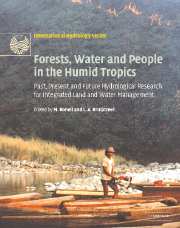 Forests, Water and People in the Humid Tropics
Forests, Water and People in the Humid Tropics Book contents
- Frontmatter
- Contents
- List of contributors
- Foreword
- Preface
- Acknowledgements
- Symposium and Workshop
- Introduction
- Part I Current trends and perspectives on people–land use–water issues
- Part II Hydrological processes in undisturbed forests
- Part III Forest disturbance, conversion and recovery
- Part IV New methods for evaluating effects of land-use change
- 27 Remote sensing tools in tropical forest hydrology: new sensors
- 28 Detecting change in river flow series
- 29 How to choose an appropriate catchment model
- 30 The disaggregation of monthly streamflow for ungauged sub-catchments of a gauged irrigated catchment in northern Thailand
- 31 Parsimonious spatial representation of tropical soils within dynamic rainfall—runoff models
- 32 Isotope tracers in catchment hydrology in the humid tropics
- 33 Process-based erosion modelling: promises and progress
- 34 Impacts of forest conversion on the ecology of streams in the humid tropics
- Part V Critical appraisals of best management practices
- Conclusion: Forests, water and people in the humid tropics: an emerging view
- Plate section
- References
33 - Process-based erosion modelling: promises and progress
from Part IV - New methods for evaluating effects of land-use change
Published online by Cambridge University Press: 12 January 2010
- Frontmatter
- Contents
- List of contributors
- Foreword
- Preface
- Acknowledgements
- Symposium and Workshop
- Introduction
- Part I Current trends and perspectives on people–land use–water issues
- Part II Hydrological processes in undisturbed forests
- Part III Forest disturbance, conversion and recovery
- Part IV New methods for evaluating effects of land-use change
- 27 Remote sensing tools in tropical forest hydrology: new sensors
- 28 Detecting change in river flow series
- 29 How to choose an appropriate catchment model
- 30 The disaggregation of monthly streamflow for ungauged sub-catchments of a gauged irrigated catchment in northern Thailand
- 31 Parsimonious spatial representation of tropical soils within dynamic rainfall—runoff models
- 32 Isotope tracers in catchment hydrology in the humid tropics
- 33 Process-based erosion modelling: promises and progress
- 34 Impacts of forest conversion on the ecology of streams in the humid tropics
- Part V Critical appraisals of best management practices
- Conclusion: Forests, water and people in the humid tropics: an emerging view
- Plate section
- References
Summary
INTRODUCTION
Accelerated soil and nutrient losses and their off-site impacts are of great concern for sustainable agriculture and, more generally, for sustainable land management. Prediction of the rate of soil erosion over a range of temporal and spatial scales is important for land use planning, erosion risk assessment, and for evaluating the effects of land use change (Penning de Vries et al., 1998). With urbanisation and population growth in traditionally rural areas, farming on steeplands has continued to increase in recent years, especially in the developing regions of the world (Oldeman et al., 1991; Fisher and Heilig, 1997). In plantation forestry, logging and site preparation activities on steep slopes also expose forested areas temporarily to high risk of soil erosion and nutrient losses (cf. the chapter by Grip et al., this volume).
The most widely used soil erosion prediction technology is the Universal Soil Loss Equation (USLE) (Wischmeier and Smith, 1978) and its successor the Revised USLE (Renard et al., 1997). In recent years, however, a new generation of physically based models such as WEPP (Nearing et al., 1989; Flanagan and Nearing, 1995; Laflen et al., 1997), LISEM (De Roo et al., 1996a), EUROSEM (Morgan et al., 1998) and GUEST (Misra and Rose, 1996; Rose et al., 1997) has been developed to describe and quantify soil erosion processes. These models are particularly suitable for adaptation across a range of scales in the landscape because physical principles and physically meaningful parameters are involved.
- Type
- Chapter
- Information
- Forests, Water and People in the Humid TropicsPast, Present and Future Hydrological Research for Integrated Land and Water Management, pp. 790 - 810Publisher: Cambridge University PressPrint publication year: 2005
References
- 5
- Cited by


